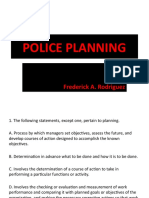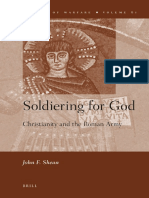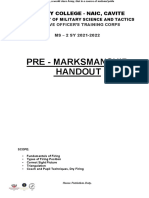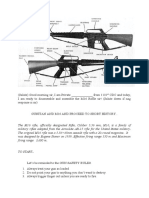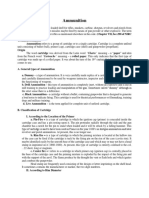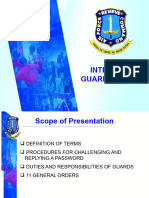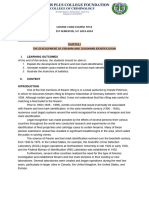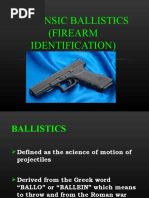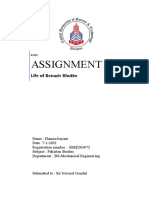Polytechnic University of The Philippines Rotc Unit: Anonas Street, Sta. Mesa, Manila
Polytechnic University of The Philippines Rotc Unit: Anonas Street, Sta. Mesa, Manila
Uploaded by
Angelica RoseCopyright:
Available Formats
Polytechnic University of The Philippines Rotc Unit: Anonas Street, Sta. Mesa, Manila
Polytechnic University of The Philippines Rotc Unit: Anonas Street, Sta. Mesa, Manila
Uploaded by
Angelica RoseOriginal Title
Copyright
Available Formats
Share this document
Did you find this document useful?
Is this content inappropriate?
Copyright:
Available Formats
Polytechnic University of The Philippines Rotc Unit: Anonas Street, Sta. Mesa, Manila
Polytechnic University of The Philippines Rotc Unit: Anonas Street, Sta. Mesa, Manila
Uploaded by
Angelica RoseCopyright:
Available Formats
POLYTECHNIC UNIVERSITY OF THE PHILIPPINES ROTC UNIT
1304TH COMMUNITY DEFENSE CENTER, ARESCOM, PA
NATIONAL SERVICE TRAINING PROGRAM
DEPARTMENT OF MILITARY SCIENCE AND TACTICS
Anonas Street, Sta. Mesa, Manila
PUPROTCU HANDOUTS 20-21
PRE-MARKSMANSHIP TRAINING
I. INTRODUCTION
An infantryman's basic battlefield tool is his weapon. To effectively employ
his weapon, marksmanship must be mastered from the basics of rifle marksmanship
to the advanced stages of target engagement. This will greatly enhance the
infantryman's capability to close with and destroy the enemy. Understanding the
operation and functions of any machine is vital to becoming an expert with that
machine. The same theory applies to rifle marksmanship. Commanders must keep
this in mind when setting up a training program. A soldier is able to assess and correct
any malfunction to keep the weapon always operating properly.
II. CLEARING
Point in a SAFE DIRECTION! Place selector lever on SAFE. If weapon is not
cocked, lever cannot be pointed toward SAFE.
Remove the magazine by depressing the magazine catch button and pulling
the magazine down.
To lock bolt open, pull charging handle rearward. Press bottom of bolt catch
and allow bolt to move forward until it engages bolt catch. Return charging
handle to full forward position.
Check receiver and chamber to ensure these areas contain no ammo.
With selector lever pointing toward SAFE, allow bolt to go forward by pressing
upper portion of bolt catch.
III. CYCLES OF FUNCTIONING
1. Feeding – the bolt carrier group moves rearward, it engages the buffer
assembly and compresses the action spring into the lower receiver extension.
When the bolt carrier group clears the top of the magazine, the expansion of the
magazine spring forces the follower and a new round up into the path of the forward
movement of the bolt. The expansion of the action spring sends the buffer
assembly and bolt carrier group forward with enough force to strip a new round
from the magazine.
Prepared by PUP ROTCU, (MS-1, SY 2020-2021) Page 1 of 9
POLYTECHNIC UNIVERSITY OF THE PHILIPPINES ROTC UNIT
1304TH COMMUNITY DEFENSE CENTER, ARESCOM, PA
NATIONAL SERVICE TRAINING PROGRAM
DEPARTMENT OF MILITARY SCIENCE AND TACTICS
Anonas Street, Sta. Mesa, Manila
2. Chambering – the bolt carrier group continues to move forward, the face of
the bolt thrusts the new round into the chamber. At the same time, the extractor
claw grips the rim of the cartridge, and the ejector is compressed.
3. Locking – the bolt carrier group moves forward, the bolt is kept in its most
forward position by the bolt cam pin riding in the guide channel in the upper
receiver. Just before the bolt locking lugs make contact with the barrel extension,
the bolt cam pin emerges from the guide channel. The rifle is ready to fire.
4. Firing – the trigger rotates on the trigger pin, depressing the nose of the
trigger, and disengaging the notch on the bottom of the hammer. The hammer
spring drives the hammer forward. The hammer strikes the head of the firing pin,
driving the firing pin through the bolt into the primer of the round. When the primer
is struck by the firing pin, it ignites and causes the powder in the cartridge to ignite.
The gas tube directs the gas into the bolt carrier. It passes through the key
downward into a space between the rear of the carrier's bolt cavity and the rear of
the bolt itself. The gas then expands. The bolt is locked into the barrel extension
and unable to move forward, and the carrier is thus forced to the rear by the
expanding gas.
5. Unlocking – the bolt carrier moves to the rear, the bolt cam pin follows the
path of the cam track (located in the bolt carrier). This action causes the cam pin
and bolt assembly to rotate simultaneously until the locking lugs of the bolt are no
longer in line behind the locking lugs of the barrel extension.
6. Ejecting – with the base of a cartridge case firmly against the face of the
bolt, the ejector and ejector spring are compressed into the bolt body. As the
rearward movement of the bolt carrier group allows the nose of the cartridge case
to clear the front of the ejection port, the cartridge is pushed out by the action of
the ejector and spring.
7. Cocking – the rearward movement of the bolt carrier overrides the hammer,
forcing it down into the receiver and compressing the hammer spring, cocking the
hammer in the firing position. The action of the rifle is much faster than human
reaction; therefore, the firer cannot release the trigger fast enough to prevent
multiple firing.
Prepared by PUP ROTCU, (MS-1, SY 2020-2021) Page 2 of 9
POLYTECHNIC UNIVERSITY OF THE PHILIPPINES ROTC UNIT
1304TH COMMUNITY DEFENSE CENTER, ARESCOM, PA
NATIONAL SERVICE TRAINING PROGRAM
DEPARTMENT OF MILITARY SCIENCE AND TACTICS
Anonas Street, Sta. Mesa, Manila
IV. FOUR BASIC FUNDAMENTALS OF MARKSMANSHIP
1. Steady Position – before a soldier can hit targets, he must learn to hold the
weapon in a steady position. This is an initial shooting skill the soldier should
master
a. Supported Position – soldiers should be encouraged always to fire from
supported position when possible. Any type of support (sandbags, tree,
rubble file, walls, etc) will greatly assist shooting accuracy.
b. Unsupported Position – soldiers must learn to hold the weapon steady
without support. The record file course utilizes the prone unsupported
position. The steadiest of all unsupported positions.
There are Three (3) firing positions commonly used. These are the Prone
position, Kneeling/Squatting/Sitting/Cross-legged position and Standing
position. In order to have a good and stable position, the soldier should bear
in mind the three elements of stable position.
Bone Support – positions are designed as foundation of the rifle. It
should be stressed that a good foundation of a rifle is important. It is
uncomfortable to a house built in a weak foundation; the house stands
erect. This is same through to a rifle shooter who established a weak
foundation for a rifle, withstand the repeated recoil of a rifle.
Muscular Relaxation – the rifle shooter must learn to relax as much as
possible in the various firing position, avoid unnecessary muscular
tension in an effort to hold in the aiming area.
Natural Point of Aim on the Target – natural point of aim is established
during respiratory pause, since the shooter and the rifle becomes single
steady unit or the rifle become the extension of the body, it is but
necessary to adjust the position of the body until the rifle points or aim
naturally.
Eight Steady Hold Factors:
1. Grip of the Non-Firing Hand – the new emphasis here is to relax
the grip of the non-firing hand
2. Rifle Butt in the Pocket of the Shoulder – again, emphasis here is
to avoid holding the butt of the weapon very tightly into the pocket of
the shoulder, promoting a more relaxed position. Also, holding the
weapon only lightly into the shoulder reduces the effects of breathing
Prepared by PUP ROTCU, (MS-1, SY 2020-2021) Page 3 of 9
POLYTECHNIC UNIVERSITY OF THE PHILIPPINES ROTC UNIT
1304TH COMMUNITY DEFENSE CENTER, ARESCOM, PA
NATIONAL SERVICE TRAINING PROGRAM
DEPARTMENT OF MILITARY SCIENCE AND TACTICS
Anonas Street, Sta. Mesa, Manila
and other body movement. In other words, when the rifle is held
tightly against the chest cavity, there will be significant movement of
the rifle during the natural breathing process.
3. Grip of the Firing Hand – it is appropriate to apply the rearward
pressure required to keep the butt of the weapon in the pocket of the
shoulder with the firing hand. Emphasis here is that the placement of
the trigger is dependent upon hand size, strength, and the weight
required to pull the trigger. The objective is to make the hammer fall
without disturbing the lay of the weapon.
4. Firing Elbow – when possible, the elbow is firmly planted to help
insure a steady position.
5. Stock weld – the stock weld is taught as an integral part of various
positions. Two (2) key factors emphasized are that the stock weld
should provide for a natural line of sight through the center of the
aperture to the front sight, and the eye should be close to the rear
sight.
6. Breathing – the rhythmical movement of the chest, elbow and
shoulder. The rise and fall of the chest cause compulsory movement
of the muzzle of the rifle. The primary technique for the control of
breathing is to lock the breath at any point within the breathing cycle
as the trigger is squeezed - most combat targets will not wait around
for the moment of natural respiratory pause. Breathing is included as
one of the four (4) fundamentals.
7. Relaxation – undue muscle strain or tension causes trembling which
is transmitted to the rifle. Relaxation is important, but some problems
could be expected in getting a soldier to relax while a horde of enemy
soldiers are charging his position to kill him; therefore, relaxation has
been built into firing position by relaxing the grip on the weapon.
2. Aiming – the act of pointing the rifle so that the projectile will hit the desired
target. The precise alignment of the rifle to the target. The rear open sight is the
least accurate of the three (3) sighting systems and requires that three objects be
brought into alignment; the rear sight, the front sight, and the target.
There are four things that you should remember when aiming.
1) Focus the tip of the front sight post on the target.
2) Focus the tip of the front sight post on the target precisely centered in the
rear aperture.
Prepared by PUP ROTCU, (MS-1, SY 2020-2021) Page 4 of 9
POLYTECHNIC UNIVERSITY OF THE PHILIPPINES ROTC UNIT
1304TH COMMUNITY DEFENSE CENTER, ARESCOM, PA
NATIONAL SERVICE TRAINING PROGRAM
DEPARTMENT OF MILITARY SCIENCE AND TACTICS
Anonas Street, Sta. Mesa, Manila
3) Establish the appropriate point of aim and then bring the focus of the eye
to the front tip as the front sight post is move on the target.
4) Breathing must be ceased or stopped to ensure that the rear sight, front
sight and target are all in proper alignment. The peeping eye should be
placed behind the rear aperture approximately two (2) inches with the
check rested on the small of the stock.
3. Breathing Control – it is impossible to maintain a steady position, keeping the
tip of the front sight post at the precise aiming point, while breathing in an out.
Control the breathing to help keep the rifle steady during trigger squeeze. The
shot must be then fired before feeling any unpleasant sensations from ceasing
breathing.
You should remember that when exercising breath control,
a) You should maintain steady position keeping the tip of the front sight post
at the precise aiming point while breathing in and out.
b) Proper placement of the trigger finger on the trigger in between the
fingertip and the first joint or between the first joint and second joint of the
pad.
c) You should also remember that trigger finger must be in an arched position
to avoid contact in any part of the rifle.
d) Squeeze along the barrel: Backward and forward movement of the trigger
finger on the trigger without any twisting movement to the left or right.
4. Trigger Squeeze – it is the independent action of the forefinger on trigger with a
uniformly increasing pressure straight to the rear as long as the desired perfect
sight picture is maintained. Trigger squeeze is vitally important for two (2)
reasons:
1. Any sudden movement of the finger on the trigger disturbs the lay of the
weapon, and therefore, causes the shot to miss its intended target.
2. However, the most important reason for squeezing the trigger is that the
exact moment of weapon firing must be a complete surprise to the firer.
From the unsupported position, a small wobble area normally exists. The
wobble area is the movement of the sight around the aiming point when the
weapon is in the steadiest possible position. If wobble is present, the same
trigger squeeze technique should be employed. The best firing performance
will result when the trigger is squeezed continuously while the smallest
Prepared by PUP ROTCU, (MS-1, SY 2020-2021) Page 5 of 9
POLYTECHNIC UNIVERSITY OF THE PHILIPPINES ROTC UNIT
1304TH COMMUNITY DEFENSE CENTER, ARESCOM, PA
NATIONAL SERVICE TRAINING PROGRAM
DEPARTMENT OF MILITARY SCIENCE AND TACTICS
Anonas Street, Sta. Mesa, Manila
possible wobble area is maintained, and the actual moment of firing cannot
be anticipated.
Sequence of Trigger Squeeze
1. Breath – hold breath
2. Relax – release a little air and hold
3. Aim – complete sight alignment
4. Slack – take a slack with initial pressure ½ of the weight to pull the
trigger.
5. Squeeze – apply pressure to the remaining resistance.
6. Follow Through – it is the continued mechanical and mental
application of fundamentals after each round has been fired, this
simply means the firer maintain his stable position, aiming, breath
control, and continue to press the trigger to the rear even though the
rifle has fired already.
V. DRY FIRE
Firing a shot exactly as live bullet would be fired except with an empty chamber.
This is a method of training widely used by top marksman throughout the world.
Objective of Dry Fire – to master the four (4) fundamentals of marksmanship in a
relax environment, the firer will be able to:
Assume good firing position in comfortable manner.
Fully understand the aiming process,
Breath control will be second in nature.
Trigger squeeze is practiced or mastered.
Devices Use in Dry Fire
1. Aiming Card – simple device which is used to determine if the soldier
understands the aiming process and how to aim at target center of mass.
2. Riddle Sighting Device – this allows the trainer to see if the soldier
understands the aiming process while using his own rifle. The device is a small
plastic plate with a magnet attached and a drawing of a small E- type silhouette
target.
3. Paige Sighting Device – it serves the same purpose as the riddle device – to
teach, diagnose, and practice the fundamentals of aiming. The Paige sighting
device consists of a metal target piece and a spring, which is fixed on a wooden
spindle and is inserted in the rifle barrel.
Prepared by PUP ROTCU, (MS-1, SY 2020-2021) Page 6 of 9
POLYTECHNIC UNIVERSITY OF THE PHILIPPINES ROTC UNIT
1304TH COMMUNITY DEFENSE CENTER, ARESCOM, PA
NATIONAL SERVICE TRAINING PROGRAM
DEPARTMENT OF MILITARY SCIENCE AND TACTICS
Anonas Street, Sta. Mesa, Manila
4. The Dime/Washer Exercise – it determines if the soldier has a smooth trigger
pull. It is more effective when conducted from an unsupported position. The rifle
is cocked and the soldier assumes a good firing position, an assistant place a
dime or a washer on the barrel between the sight assembly and flash
suppressor and then the soldier attempts to pull the trigger without causing the
dime/washer to fall. To enhance this training, the soldier should be aiming at a
target when he pulls the trigger.
5. Target Box Exercise – it is an excellent procedure for checking the consistency
of aiming from shot to shot and the consistent placement of shot group in a dry
environment.
6. Ball and Dummy Exercise – it is conducted on a live fire range during actual
firing; however, soldier should be taught the ball and dummy exercises during
PMT so it can be conducted by a soldier-coach on the firing range. This exercise
is an excellent means of detecting if the soldier knows when the rifle is going to
fire.
7. Modified Silhouette Targets – the use of modified silhouette target is not
appropriate for most soldiers; however, they may prove useful to a few soldiers
who experience difficulty understanding center-of-mass aiming. By using this
target during PMT, the soldier can adjust his aiming point until the white just
disappears, and it may assist him in learning how to aim at center-of-mass.
VI. SIGHT ADJUSTMENT
All soldiers should be confident they can correctly adjust sights for windage and
elevation before they get to the live fire range. States that one click of the elevation or
windage will move the strike of the projectile at a specific distance at a specific range. At
range twenty-five (25) meters, one click of either the elevation or windage will move the
strike of the projectile approximately .7 cm.
Steps in Sight Adjustment
1. Ensure that soldiers understand the general concept of zeroing. The use of
long-range sight and adjusting sights until the point of aim and bullet strike
are the same at 25 meters, will result in a good 250 meter zero when the
regular sight is used. Flip between the regular sight and long-range sigh to
ensure that the sight is used for zeroing (at long range shooting) and the
unmarked sight is used for all normal firing (battle sight zero).
Prepared by PUP ROTCU, (MS-1, SY 2020-2021) Page 7 of 9
POLYTECHNIC UNIVERSITY OF THE PHILIPPINES ROTC UNIT
1304TH COMMUNITY DEFENSE CENTER, ARESCOM, PA
NATIONAL SERVICE TRAINING PROGRAM
DEPARTMENT OF MILITARY SCIENCE AND TACTICS
Anonas Street, Sta. Mesa, Manila
2. Next step is to find the lines which cross at a point closest to the center of
the shot group.
3. Next is to ensure that soldiers can transfer the information from the zero
target to the rifle. Turn the front sight in a clockwise direction and the rear in
a clockwise direction (in accordance with the sight change requirements).
VII. GROUPING
It is a form of practice firing. There are two (2) primary objectives – shooting
tight shot group and the consistent placement of those groups. It appropriately falls
between dry fire exercise and zeroing. The initial live fire training should be a grouping
exercise. The purpose of a grouping exercise is to practice and refine shooting
fundamentals. It is important to note that this is not a zeroing exercise, therefore, very
few sight changes should be made.
VIII. ZEROING
The purpose of zeroing is to increase hit probability in combat. Zeroing
involves the adjustment of sights until bullets hit the same place the rifle is aimed when
shooting targets at a distance of 250 meters.
Concept of Zeroing - When a rifle is zeroed, the sights are adjusted so that
bullet strike will be the same at point of aim at a given range.
IX. RANGE SAFETY PRECAUTIONS
1. The bolt of the rifle must be opened.
2. All loading and unloading are executed on the firing line with the muzzle of the
rifle point towards the target
3. No weapon is loaded until the command is given
4. All firing must be controlled by signal, command will be given by the designated
Range Officer/NCO. Do not fire until the command is given.
5. At the command all trigger finger must automatically remove from the trigger
and shift to safe position.
6. No weapon is to be remove from the firing line until it has been inspected to see
to it that it is clear with ammo and the safely lever is safe and bolt is opened.
7. No person is allowed beyond the firing line for any reason or purpose. No
weapon is carried in front of the firing line.
8. After firing, place the selector lever at safe, remove magazine, and always keep
the bolt open.
Prepared by PUP ROTCU, (MS-1, SY 2020-2021) Page 8 of 9
POLYTECHNIC UNIVERSITY OF THE PHILIPPINES ROTC UNIT
1304TH COMMUNITY DEFENSE CENTER, ARESCOM, PA
NATIONAL SERVICE TRAINING PROGRAM
DEPARTMENT OF MILITARY SCIENCE AND TACTICS
Anonas Street, Sta. Mesa, Manila
9. If in case malfunction or alibi, do immediate action or remedial action with the
barrel pointing to the target. If failed, put down your rifle, raise your hand and
shout alibi to be assisted by Coach or Range NCO.
10. Anyone observing an unsafe act will immediately call.
11. Consider the rifle loaded at all times, even in the break areas. Never point the
rifle to anyone.
Prepared by PUP ROTCU, (MS-1, SY 2020-2021) Page 9 of 9
You might also like
- History of Forensic BallisticsDocument10 pagesHistory of Forensic BallisticsAlfred Louis Salivia DizonNo ratings yet
- CIA - Balkan Battlegrounds - A Military History of The Yugoslav Conflict, 1990-1995, Vol. IIDocument680 pagesCIA - Balkan Battlegrounds - A Military History of The Yugoslav Conflict, 1990-1995, Vol. IINatasha RossiNo ratings yet
- Marksmanship Theory & CoachingDocument91 pagesMarksmanship Theory & Coachingadamhome100% (1)
- Christopher Duffy - Russia's Military Way To The West - Origins & Nature of Russian Military Power 1700-1800Document270 pagesChristopher Duffy - Russia's Military Way To The West - Origins & Nature of Russian Military Power 1700-1800SwamiVNNo ratings yet
- Module 5 TRW Final OutputDocument5 pagesModule 5 TRW Final OutputHersheykris PimentelNo ratings yet
- Fundamentals of Pistol MarksmanshipDocument27 pagesFundamentals of Pistol MarksmanshipRamos CasapaoNo ratings yet
- Introduction To BallisticsDocument8 pagesIntroduction To BallisticssharlynfaithloquireNo ratings yet
- Police Planning: Frederick A. RodriguezDocument64 pagesPolice Planning: Frederick A. RodriguezLeslie Banaag100% (1)
- Fundamentals of Pistol MarksmanshipDocument12 pagesFundamentals of Pistol Marksmanshipx6ryan100% (7)
- Christianity and The Roman ArmyDocument477 pagesChristianity and The Roman ArmyHristo Petrov Tuhchiev100% (2)
- Module 3Document8 pagesModule 3Amber EbayaNo ratings yet
- Basic: C/Maj Angelica A Paet 1Cl S1-AdjutantDocument27 pagesBasic: C/Maj Angelica A Paet 1Cl S1-AdjutantAlysszandra100% (1)
- Firearms and Weapon Handling1Document42 pagesFirearms and Weapon Handling1AceAsabu100% (1)
- DT 104 - Module 3 (Part 1)Document41 pagesDT 104 - Module 3 (Part 1)mart09211991No ratings yet
- Pre Marksmanship ModuleDocument9 pagesPre Marksmanship ModuleJustin Perea100% (1)
- MarksmanshipDocument11 pagesMarksmanshipDm CincoNo ratings yet
- Markmanship OKDocument14 pagesMarkmanship OKMA. FRANCESCA DUCOTNo ratings yet
- Pe-4 MarksmanshipDocument13 pagesPe-4 MarksmanshipheycablaoNo ratings yet
- 11 Marches BivouacsDocument53 pages11 Marches BivouacsDAGUMAN, RICHMOND CASEY100% (1)
- Lesson 3 Fundamentals of MarksmanshipDocument14 pagesLesson 3 Fundamentals of MarksmanshipSegunto, Rafhael G.No ratings yet
- Principles of MarksmanshipDocument3 pagesPrinciples of MarksmanshipArvy ArvyNo ratings yet
- Markmanship (Cal.45pistol)Document26 pagesMarkmanship (Cal.45pistol)Jarvie JohnNo ratings yet
- m16 ScriptDocument4 pagesm16 ScriptAlper PugoyNo ratings yet
- Fundamentals of MarksmanshipDocument23 pagesFundamentals of MarksmanshipYan-Yan BaladecNo ratings yet
- Chapter 6 - Disassembly and Assembly of FirearmDocument4 pagesChapter 6 - Disassembly and Assembly of FirearmVILLANUEVA, MARIALYN BNo ratings yet
- Marksmanship PrinciplesDocument3 pagesMarksmanship Principlesapi-3772243100% (3)
- Ballistic ModuleDocument6 pagesBallistic ModuleJoseNo ratings yet
- Protocol For Explosives Incident InvestigationDocument23 pagesProtocol For Explosives Incident Investigationmarcornelant lersunlisdan50% (2)
- MS 3 16 Weapons TrainingDocument12 pagesMS 3 16 Weapons TrainingKurt Eric Bucol100% (1)
- Ballistics ReviewDocument11 pagesBallistics ReviewJudy Ann AciertoNo ratings yet
- Basic MarkmanshipDocument83 pagesBasic MarkmanshipMark Anthony palomerNo ratings yet
- Cri 007 HandoutsDocument12 pagesCri 007 HandoutscriminologyallianceNo ratings yet
- Comprehensive Handout On Forensic Ballistics by Dr. Jezreel Vicente at University of Baguio (Mobile No. 0917-8799-515Document15 pagesComprehensive Handout On Forensic Ballistics by Dr. Jezreel Vicente at University of Baguio (Mobile No. 0917-8799-515VincentNo ratings yet
- IntelligenceDocument12 pagesIntelligenceArvin YamsonNo ratings yet
- Firearms ClassificationDocument3 pagesFirearms ClassificationJohn Francis Arellano BatohanonNo ratings yet
- Ballistics Final Project - Workbook Diego Gregorio BSC 4aDocument56 pagesBallistics Final Project - Workbook Diego Gregorio BSC 4aDiego GregorioNo ratings yet
- Workbook BallisticDocument43 pagesWorkbook BallisticMyrell Mikiu Remperas Galorio100% (1)
- PNP Policing and Inter Agency Approach With Specialized Law Enforcement AgenciesDocument3 pagesPNP Policing and Inter Agency Approach With Specialized Law Enforcement AgenciesRowena100% (1)
- Basic Mil Knowledge Interior Guard DutiesDocument24 pagesBasic Mil Knowledge Interior Guard DutiesReniel De Guzman100% (1)
- Marksmanship 2024Document42 pagesMarksmanship 2024Western - Rica Jane LozanoNo ratings yet
- Identification of Modern Firearms UsingDocument66 pagesIdentification of Modern Firearms UsingSal McGaundieNo ratings yet
- FOR6 Week 1 3Document23 pagesFOR6 Week 1 3Atasha Kim ManarangNo ratings yet
- Personnel SecurityDocument26 pagesPersonnel SecuritynetbuddyNo ratings yet
- Forensic Med Lecture 7 (Chapter 7 Firearm & Explosion)Document24 pagesForensic Med Lecture 7 (Chapter 7 Firearm & Explosion)MowlidAbdirahman Ali madaaleNo ratings yet
- Intelligence and Secret Service Definition of TermsDocument5 pagesIntelligence and Secret Service Definition of TermsName ToomNo ratings yet
- Criminalistics Compilation Notes - 2Document215 pagesCriminalistics Compilation Notes - 2Ldrrmo Ipil100% (1)
- Chapter 1 Personal IdentificationDocument99 pagesChapter 1 Personal IdentificationJohn BernardoNo ratings yet
- UNIT VI. Gunpowder and ExplosivesDocument6 pagesUNIT VI. Gunpowder and ExplosivesMariz Althea Jem Briones100% (1)
- ANCHETAAADocument79 pagesANCHETAAAGUILAY, KEVIN MARK F.No ratings yet
- Forensic BallisticsDocument182 pagesForensic BallisticsRochel Mae Dupalco100% (1)
- Forensic Ballistics (Weebly)Document17 pagesForensic Ballistics (Weebly)Randal's CaseNo ratings yet
- Firearms Evidence Collection ProceduresDocument4 pagesFirearms Evidence Collection ProceduresWendy Annmarie Taylor100% (1)
- Notes in Forensic Ballistics Mapfiles: The AmmunitionDocument10 pagesNotes in Forensic Ballistics Mapfiles: The AmmunitionZenwel PaulaNo ratings yet
- Gun Safety 2Document70 pagesGun Safety 2Gerald HernandezNo ratings yet
- Course Syllabus in LEA 316Document6 pagesCourse Syllabus in LEA 316Melcon S. Lapina0% (1)
- Forensic Ballistics (BIGWAS)Document19 pagesForensic Ballistics (BIGWAS)KARLVINNo ratings yet
- Ballistics Final QuizDocument5 pagesBallistics Final QuizSilver LisingNo ratings yet
- MODULE 4 Fundamental With IntelDocument6 pagesMODULE 4 Fundamental With IntelPhebjoszelle Cdl Jvr LibreNo ratings yet
- Marksmanship TrainingDocument22 pagesMarksmanship TrainingRy Pomar100% (1)
- GROUP 5 Firearm Characteristics & Investigation of Ballistic CasesDocument6 pagesGROUP 5 Firearm Characteristics & Investigation of Ballistic CasesMia joy MisunoNo ratings yet
- Firearm IdentificationDocument121 pagesFirearm IdentificationRenz GadzNo ratings yet
- Module 14Document5 pagesModule 14Noemi Ladra TagotonganNo ratings yet
- 18 Weapons Training 1Document14 pages18 Weapons Training 1Michelle Esternon100% (1)
- Report EeconDocument50 pagesReport EeconAngelica RoseNo ratings yet
- Polytechnic University of The Philippines Rotc Unit: Anonas Street, Sta. Mesa, ManilaDocument3 pagesPolytechnic University of The Philippines Rotc Unit: Anonas Street, Sta. Mesa, ManilaAngelica RoseNo ratings yet
- ChemistryDocument9 pagesChemistryAngelica RoseNo ratings yet
- Faculty Marked Assignment No. 1Document12 pagesFaculty Marked Assignment No. 1Angelica RoseNo ratings yet
- Faculty Marked Assignment No. 2Document16 pagesFaculty Marked Assignment No. 2Angelica RoseNo ratings yet
- Applications of RADARDocument17 pagesApplications of RADARKalpesh KharatNo ratings yet
- WHAP - Post Classical China ReadingDocument17 pagesWHAP - Post Classical China Readingjaxn54678No ratings yet
- Chapter-22-Notes (Sections 22.1 - 22.2)Document8 pagesChapter-22-Notes (Sections 22.1 - 22.2)Mr. IntelNo ratings yet
- German Culture & The JewsDocument2 pagesGerman Culture & The JewsThe PatriotNo ratings yet
- Noc Joining Instructions Revised - 19 Feb 22Document29 pagesNoc Joining Instructions Revised - 19 Feb 22Dean ഡാനിയേൽ100% (1)
- ҰБТ-2024 МАТЕМАТИКА 1-18 Нұсқа ЖауаптарыDocument3 pagesҰБТ-2024 МАТЕМАТИКА 1-18 Нұсқа Жауаптарыtlemissova06No ratings yet
- Midn 2cl Nobleza Ker InsurgencyDocument5 pagesMidn 2cl Nobleza Ker InsurgencyKim NoblezaNo ratings yet
- Crescent and Dove Peace and Conflict Resolution in IslamDocument348 pagesCrescent and Dove Peace and Conflict Resolution in IslamPddfNo ratings yet
- S W O T and Porters Five ForcesDocument7 pagesS W O T and Porters Five ForcesBhoneMyint SanNo ratings yet
- Russian Revolution Mini-QDocument6 pagesRussian Revolution Mini-QbiscuitholtNo ratings yet
- India Wins Freedom-6Document4 pagesIndia Wins Freedom-616shaziatabassumNo ratings yet
- Ciceros Old AgeDocument20 pagesCiceros Old AgeKaveesha NethranjaleeNo ratings yet
- PrelimDocument22 pagesPrelimandrewyongNo ratings yet
- NCM - Parul Shukla - 1237Document1 pageNCM - Parul Shukla - 1237PARUL SHUKLANo ratings yet
- Civil - Military Relation Lecture NotesDocument13 pagesCivil - Military Relation Lecture Notesmastermind1642No ratings yet
- THAAD-Like High Altitude Theater Missile Defense: Strategic Defense Capability and Certain Countermeasures AnalysisDocument52 pagesTHAAD-Like High Altitude Theater Missile Defense: Strategic Defense Capability and Certain Countermeasures AnalysisReza IraniNo ratings yet
- Flying Scale Models Issue 171 2014-02Document68 pagesFlying Scale Models Issue 171 2014-02PeterNo ratings yet
- Reviewer RPHDocument8 pagesReviewer RPHLilies liliNo ratings yet
- PNP UniformsDocument3 pagesPNP UniformsUsting Noilad100% (2)
- How To Call in A 9line MEDEVAC and MIST ReportDocument1 pageHow To Call in A 9line MEDEVAC and MIST ReportCroBranNo ratings yet
- Life of Benazir BhuttoDocument6 pagesLife of Benazir BhuttoHamza KayaniNo ratings yet
- Topic 10Document8 pagesTopic 10Castro FrenzelNo ratings yet
- العصر البرونزيDocument129 pagesالعصر البرونزيalialhajj9078No ratings yet
- 5 2200 CS - Military - Specialist Coalition Millitary Specialist MiscreantDocument3 pages5 2200 CS - Military - Specialist Coalition Millitary Specialist MiscreantRYan SmtihNo ratings yet
- Kharn 1500Document11 pagesKharn 1500Romain MedanNo ratings yet
- Cover LetterDocument1 pageCover LetterAricktaNo ratings yet
- Episode 4Document49 pagesEpisode 4darnesonNo ratings yet







